Penguins Event: Implementing Total Quality Management for Success
VerifiedAdded on 2020/06/06
|11
|3040
|65
Report
AI Summary
This report provides a comprehensive analysis of Total Quality Management (TQM) within the events sector, focusing on Penguins Event, a UK-based company. It explores the history of TQM and its importance in ensuring service effectiveness and achieving business objectives. The report details the application of benchmarking, outlining its steps and advantages for self-evaluation and strategic improvement. It then critically evaluates the Six Sigma tool, including its DMAIC and DMADV methodologies, and discusses its benefits for event management, such as improved productivity, quality, customer loyalty, and cost reduction. The report emphasizes the importance of TQM tools in enhancing the competitive edge and long-term revenue of event companies. It provides a practical application of TQM principles, offering insights into how Penguins Event can leverage these strategies for organizational success and continuous improvement.
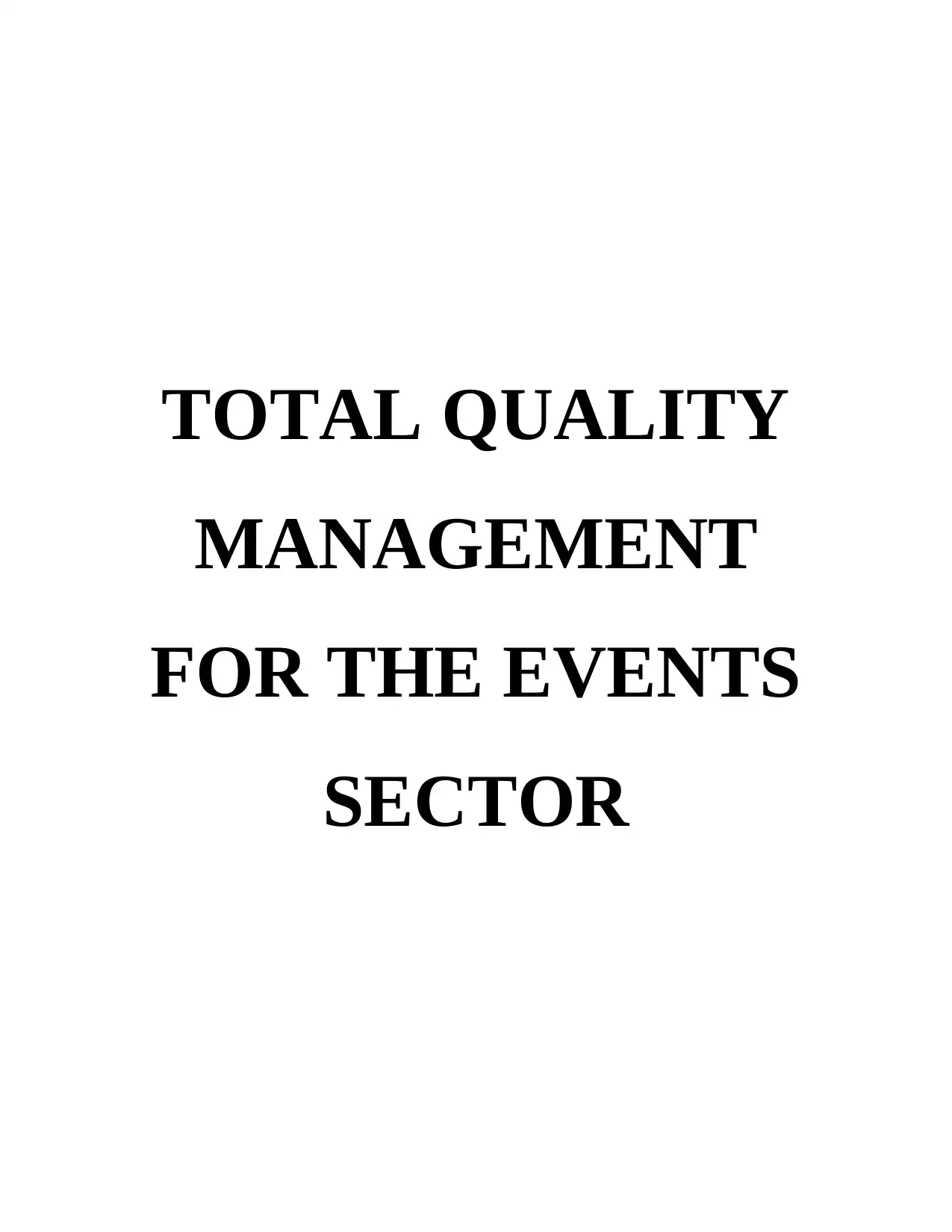
TOTAL QUALITY
MANAGEMENT
FOR THE EVENTS
SECTOR
MANAGEMENT
FOR THE EVENTS
SECTOR
Paraphrase This Document
Need a fresh take? Get an instant paraphrase of this document with our AI Paraphraser
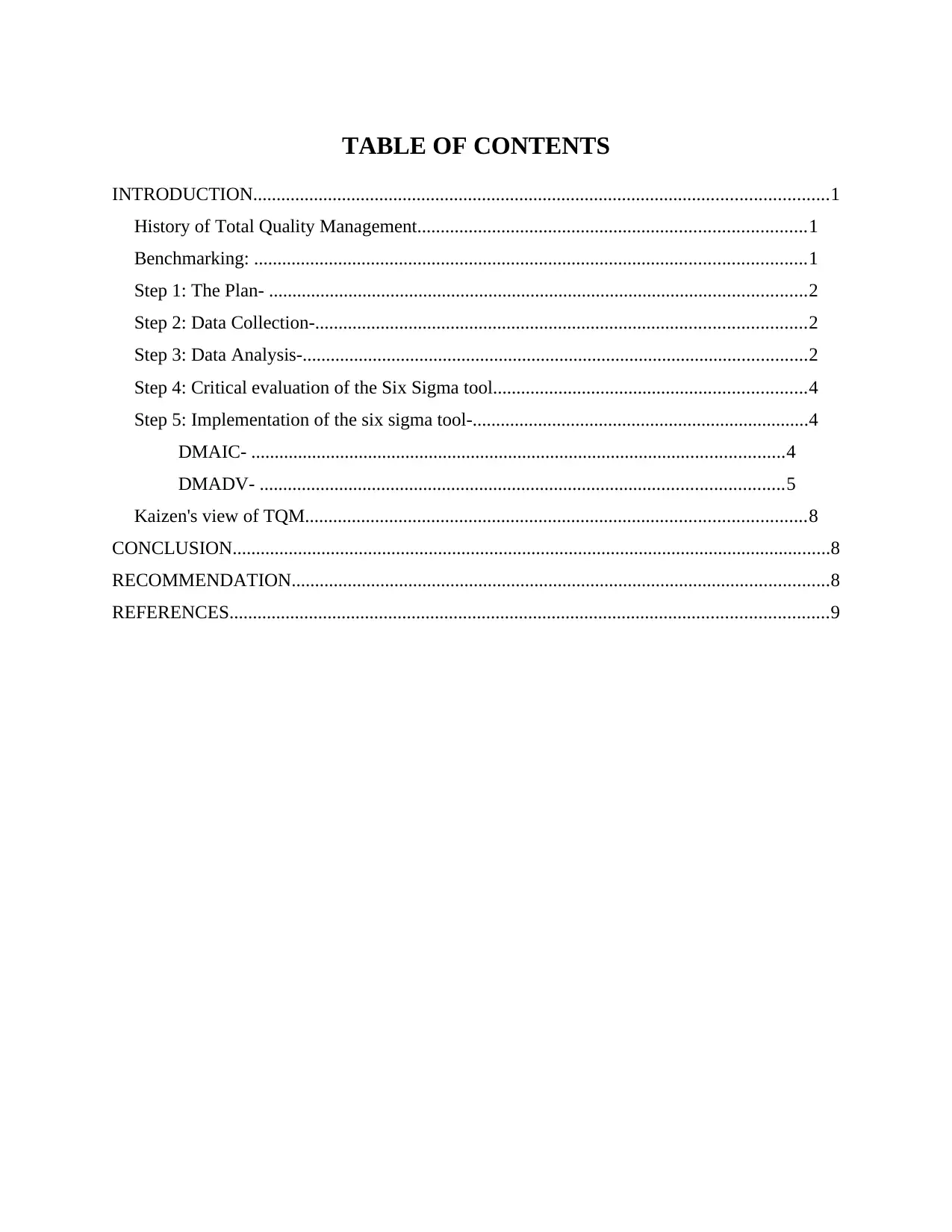
TABLE OF CONTENTS
INTRODUCTION...........................................................................................................................1
History of Total Quality Management...................................................................................1
Benchmarking: ......................................................................................................................1
Step 1: The Plan- ...................................................................................................................2
Step 2: Data Collection-.........................................................................................................2
Step 3: Data Analysis-............................................................................................................2
Step 4: Critical evaluation of the Six Sigma tool...................................................................4
Step 5: Implementation of the six sigma tool-........................................................................4
DMAIC- ..................................................................................................................4
DMADV- ................................................................................................................5
Kaizen's view of TQM...........................................................................................................8
CONCLUSION................................................................................................................................8
RECOMMENDATION...................................................................................................................8
REFERENCES................................................................................................................................9
INTRODUCTION...........................................................................................................................1
History of Total Quality Management...................................................................................1
Benchmarking: ......................................................................................................................1
Step 1: The Plan- ...................................................................................................................2
Step 2: Data Collection-.........................................................................................................2
Step 3: Data Analysis-............................................................................................................2
Step 4: Critical evaluation of the Six Sigma tool...................................................................4
Step 5: Implementation of the six sigma tool-........................................................................4
DMAIC- ..................................................................................................................4
DMADV- ................................................................................................................5
Kaizen's view of TQM...........................................................................................................8
CONCLUSION................................................................................................................................8
RECOMMENDATION...................................................................................................................8
REFERENCES................................................................................................................................9
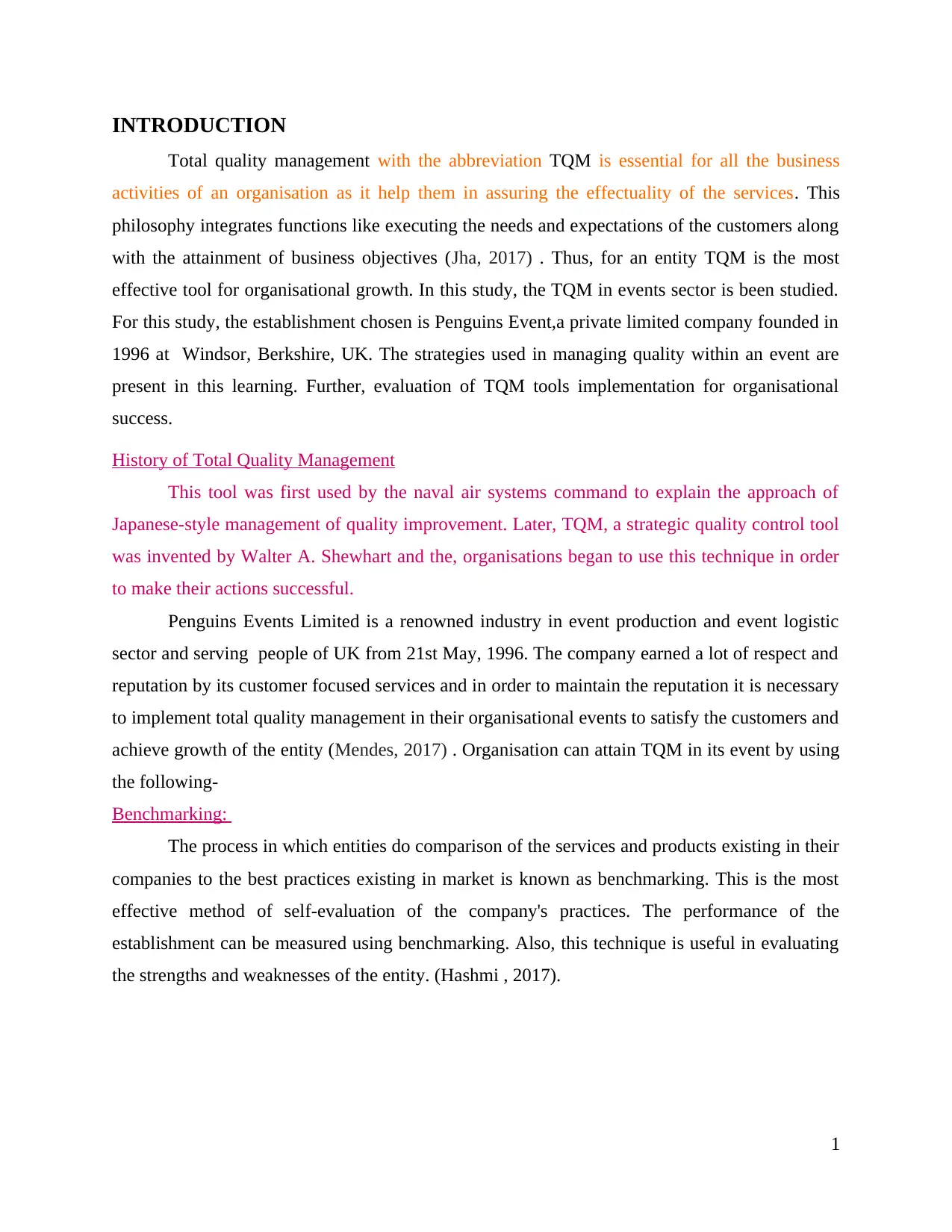
INTRODUCTION
Total quality management with the abbreviation TQM is essential for all the business
activities of an organisation as it help them in assuring the effectuality of the services. This
philosophy integrates functions like executing the needs and expectations of the customers along
with the attainment of business objectives (Jha, 2017) . Thus, for an entity TQM is the most
effective tool for organisational growth. In this study, the TQM in events sector is been studied.
For this study, the establishment chosen is Penguins Event,a private limited company founded in
1996 at Windsor, Berkshire, UK. The strategies used in managing quality within an event are
present in this learning. Further, evaluation of TQM tools implementation for organisational
success.
History of Total Quality Management
This tool was first used by the naval air systems command to explain the approach of
Japanese-style management of quality improvement. Later, TQM, a strategic quality control tool
was invented by Walter A. Shewhart and the, organisations began to use this technique in order
to make their actions successful.
Penguins Events Limited is a renowned industry in event production and event logistic
sector and serving people of UK from 21st May, 1996. The company earned a lot of respect and
reputation by its customer focused services and in order to maintain the reputation it is necessary
to implement total quality management in their organisational events to satisfy the customers and
achieve growth of the entity (Mendes, 2017) . Organisation can attain TQM in its event by using
the following-
Benchmarking:
The process in which entities do comparison of the services and products existing in their
companies to the best practices existing in market is known as benchmarking. This is the most
effective method of self-evaluation of the company's practices. The performance of the
establishment can be measured using benchmarking. Also, this technique is useful in evaluating
the strengths and weaknesses of the entity. (Hashmi , 2017).
1
Total quality management with the abbreviation TQM is essential for all the business
activities of an organisation as it help them in assuring the effectuality of the services. This
philosophy integrates functions like executing the needs and expectations of the customers along
with the attainment of business objectives (Jha, 2017) . Thus, for an entity TQM is the most
effective tool for organisational growth. In this study, the TQM in events sector is been studied.
For this study, the establishment chosen is Penguins Event,a private limited company founded in
1996 at Windsor, Berkshire, UK. The strategies used in managing quality within an event are
present in this learning. Further, evaluation of TQM tools implementation for organisational
success.
History of Total Quality Management
This tool was first used by the naval air systems command to explain the approach of
Japanese-style management of quality improvement. Later, TQM, a strategic quality control tool
was invented by Walter A. Shewhart and the, organisations began to use this technique in order
to make their actions successful.
Penguins Events Limited is a renowned industry in event production and event logistic
sector and serving people of UK from 21st May, 1996. The company earned a lot of respect and
reputation by its customer focused services and in order to maintain the reputation it is necessary
to implement total quality management in their organisational events to satisfy the customers and
achieve growth of the entity (Mendes, 2017) . Organisation can attain TQM in its event by using
the following-
Benchmarking:
The process in which entities do comparison of the services and products existing in their
companies to the best practices existing in market is known as benchmarking. This is the most
effective method of self-evaluation of the company's practices. The performance of the
establishment can be measured using benchmarking. Also, this technique is useful in evaluating
the strengths and weaknesses of the entity. (Hashmi , 2017).
1
⊘ This is a preview!⊘
Do you want full access?
Subscribe today to unlock all pages.

Trusted by 1+ million students worldwide
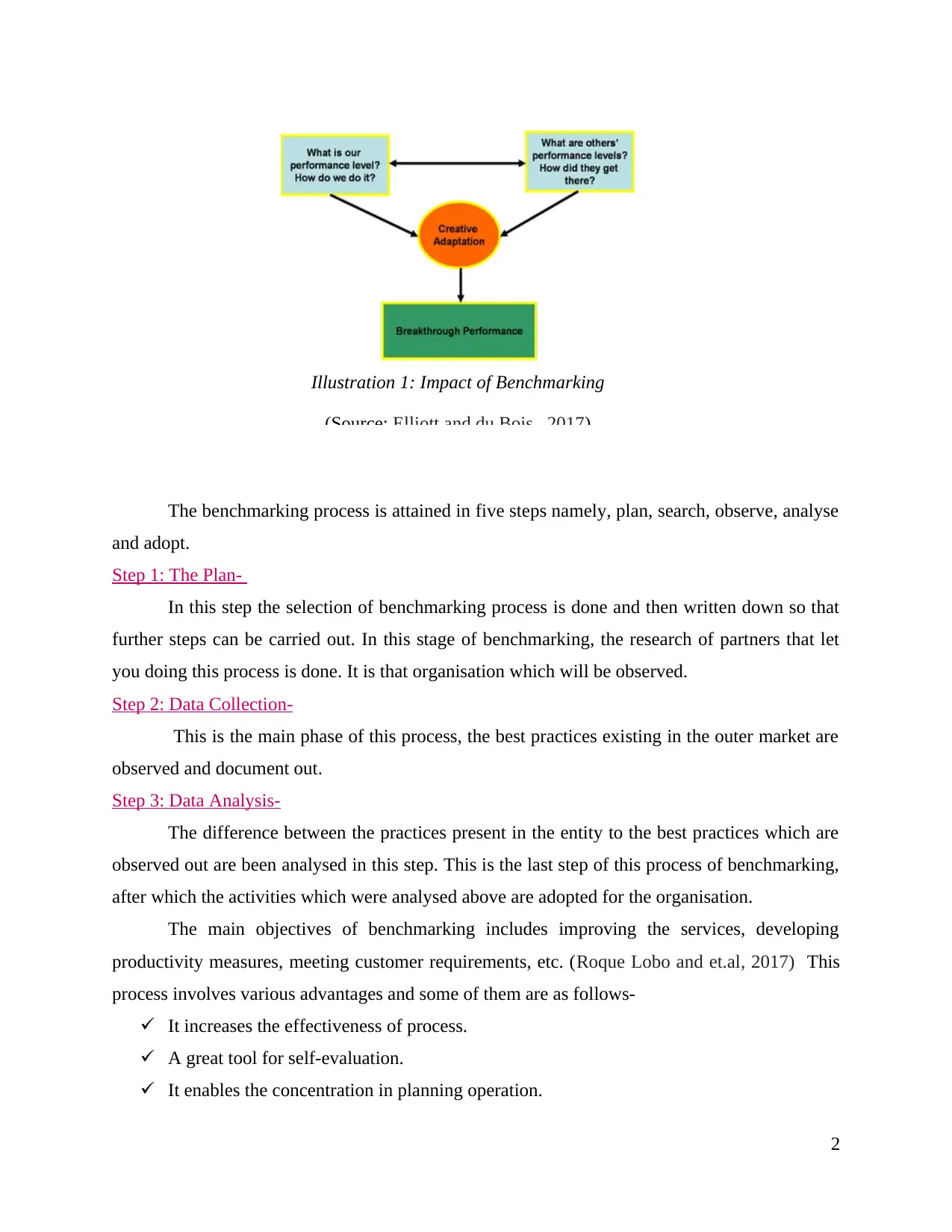
The benchmarking process is attained in five steps namely, plan, search, observe, analyse
and adopt.
Step 1: The Plan-
In this step the selection of benchmarking process is done and then written down so that
further steps can be carried out. In this stage of benchmarking, the research of partners that let
you doing this process is done. It is that organisation which will be observed.
Step 2: Data Collection-
This is the main phase of this process, the best practices existing in the outer market are
observed and document out.
Step 3: Data Analysis-
The difference between the practices present in the entity to the best practices which are
observed out are been analysed in this step. This is the last step of this process of benchmarking,
after which the activities which were analysed above are adopted for the organisation.
The main objectives of benchmarking includes improving the services, developing
productivity measures, meeting customer requirements, etc. (Roque Lobo and et.al, 2017) This
process involves various advantages and some of them are as follows-
It increases the effectiveness of process.
A great tool for self-evaluation.
It enables the concentration in planning operation.
2
Illustration 1: Impact of Benchmarking
(Source: Elliott and du Bois, 2017)
and adopt.
Step 1: The Plan-
In this step the selection of benchmarking process is done and then written down so that
further steps can be carried out. In this stage of benchmarking, the research of partners that let
you doing this process is done. It is that organisation which will be observed.
Step 2: Data Collection-
This is the main phase of this process, the best practices existing in the outer market are
observed and document out.
Step 3: Data Analysis-
The difference between the practices present in the entity to the best practices which are
observed out are been analysed in this step. This is the last step of this process of benchmarking,
after which the activities which were analysed above are adopted for the organisation.
The main objectives of benchmarking includes improving the services, developing
productivity measures, meeting customer requirements, etc. (Roque Lobo and et.al, 2017) This
process involves various advantages and some of them are as follows-
It increases the effectiveness of process.
A great tool for self-evaluation.
It enables the concentration in planning operation.
2
Illustration 1: Impact of Benchmarking
(Source: Elliott and du Bois, 2017)
Paraphrase This Document
Need a fresh take? Get an instant paraphrase of this document with our AI Paraphraser
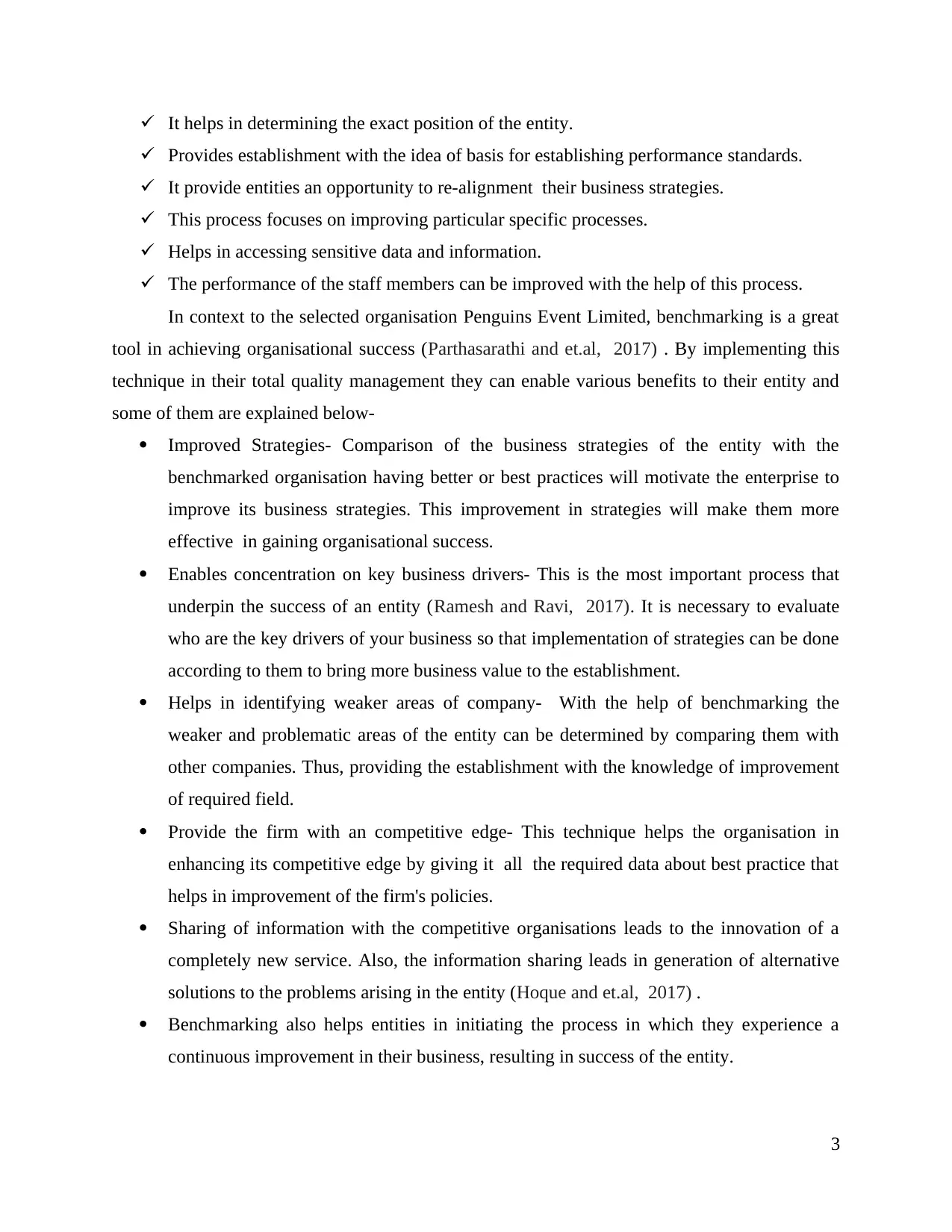
It helps in determining the exact position of the entity.
Provides establishment with the idea of basis for establishing performance standards.
It provide entities an opportunity to re-alignment their business strategies.
This process focuses on improving particular specific processes.
Helps in accessing sensitive data and information.
The performance of the staff members can be improved with the help of this process.
In context to the selected organisation Penguins Event Limited, benchmarking is a great
tool in achieving organisational success (Parthasarathi and et.al, 2017) . By implementing this
technique in their total quality management they can enable various benefits to their entity and
some of them are explained below-
Improved Strategies- Comparison of the business strategies of the entity with the
benchmarked organisation having better or best practices will motivate the enterprise to
improve its business strategies. This improvement in strategies will make them more
effective in gaining organisational success.
Enables concentration on key business drivers- This is the most important process that
underpin the success of an entity (Ramesh and Ravi, 2017). It is necessary to evaluate
who are the key drivers of your business so that implementation of strategies can be done
according to them to bring more business value to the establishment.
Helps in identifying weaker areas of company- With the help of benchmarking the
weaker and problematic areas of the entity can be determined by comparing them with
other companies. Thus, providing the establishment with the knowledge of improvement
of required field.
Provide the firm with an competitive edge- This technique helps the organisation in
enhancing its competitive edge by giving it all the required data about best practice that
helps in improvement of the firm's policies.
Sharing of information with the competitive organisations leads to the innovation of a
completely new service. Also, the information sharing leads in generation of alternative
solutions to the problems arising in the entity (Hoque and et.al, 2017) .
Benchmarking also helps entities in initiating the process in which they experience a
continuous improvement in their business, resulting in success of the entity.
3
Provides establishment with the idea of basis for establishing performance standards.
It provide entities an opportunity to re-alignment their business strategies.
This process focuses on improving particular specific processes.
Helps in accessing sensitive data and information.
The performance of the staff members can be improved with the help of this process.
In context to the selected organisation Penguins Event Limited, benchmarking is a great
tool in achieving organisational success (Parthasarathi and et.al, 2017) . By implementing this
technique in their total quality management they can enable various benefits to their entity and
some of them are explained below-
Improved Strategies- Comparison of the business strategies of the entity with the
benchmarked organisation having better or best practices will motivate the enterprise to
improve its business strategies. This improvement in strategies will make them more
effective in gaining organisational success.
Enables concentration on key business drivers- This is the most important process that
underpin the success of an entity (Ramesh and Ravi, 2017). It is necessary to evaluate
who are the key drivers of your business so that implementation of strategies can be done
according to them to bring more business value to the establishment.
Helps in identifying weaker areas of company- With the help of benchmarking the
weaker and problematic areas of the entity can be determined by comparing them with
other companies. Thus, providing the establishment with the knowledge of improvement
of required field.
Provide the firm with an competitive edge- This technique helps the organisation in
enhancing its competitive edge by giving it all the required data about best practice that
helps in improvement of the firm's policies.
Sharing of information with the competitive organisations leads to the innovation of a
completely new service. Also, the information sharing leads in generation of alternative
solutions to the problems arising in the entity (Hoque and et.al, 2017) .
Benchmarking also helps entities in initiating the process in which they experience a
continuous improvement in their business, resulting in success of the entity.
3
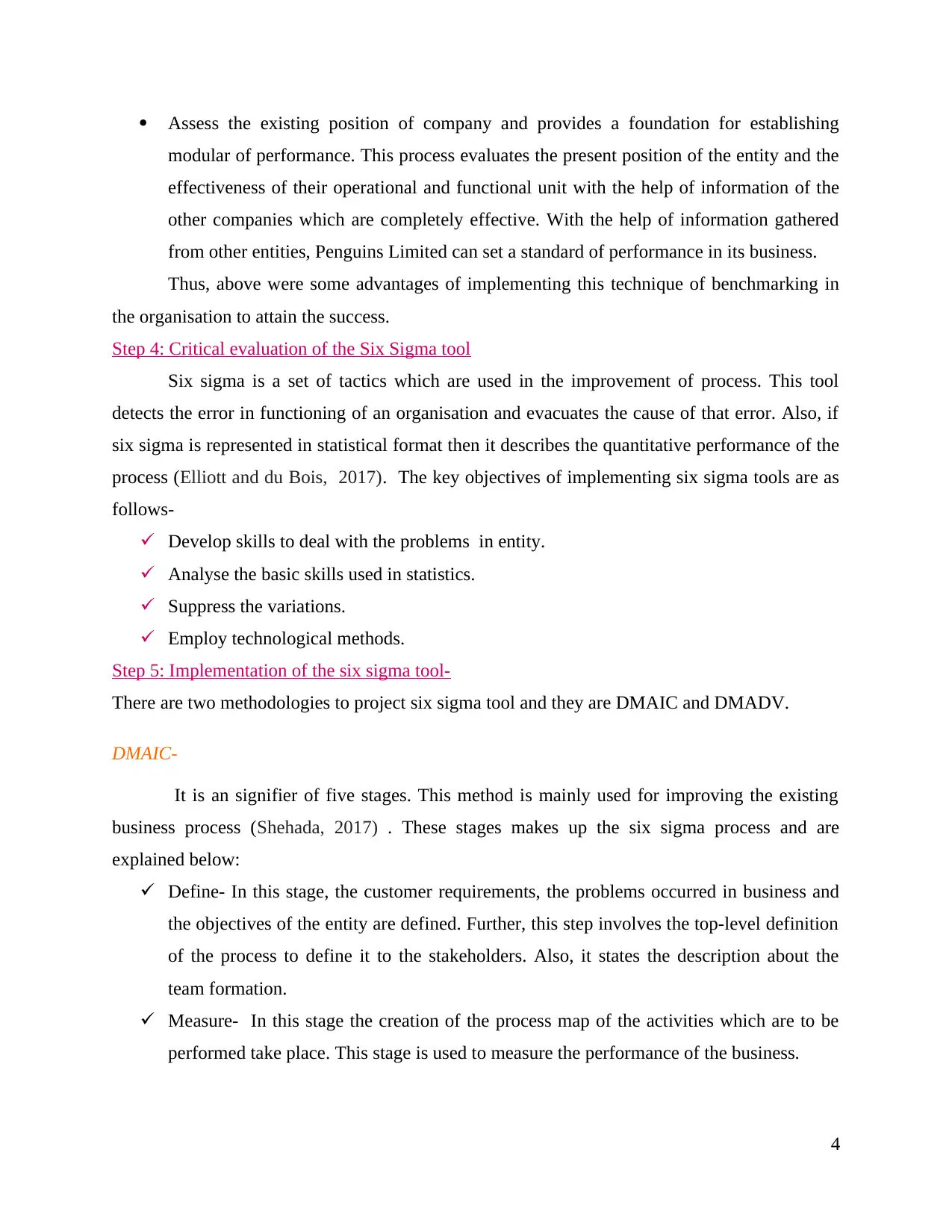
Assess the existing position of company and provides a foundation for establishing
modular of performance. This process evaluates the present position of the entity and the
effectiveness of their operational and functional unit with the help of information of the
other companies which are completely effective. With the help of information gathered
from other entities, Penguins Limited can set a standard of performance in its business.
Thus, above were some advantages of implementing this technique of benchmarking in
the organisation to attain the success.
Step 4: Critical evaluation of the Six Sigma tool
Six sigma is a set of tactics which are used in the improvement of process. This tool
detects the error in functioning of an organisation and evacuates the cause of that error. Also, if
six sigma is represented in statistical format then it describes the quantitative performance of the
process (Elliott and du Bois, 2017). The key objectives of implementing six sigma tools are as
follows-
Develop skills to deal with the problems in entity.
Analyse the basic skills used in statistics.
Suppress the variations.
Employ technological methods.
Step 5: Implementation of the six sigma tool-
There are two methodologies to project six sigma tool and they are DMAIC and DMADV.
DMAIC-
It is an signifier of five stages. This method is mainly used for improving the existing
business process (Shehada, 2017) . These stages makes up the six sigma process and are
explained below:
Define- In this stage, the customer requirements, the problems occurred in business and
the objectives of the entity are defined. Further, this step involves the top-level definition
of the process to define it to the stakeholders. Also, it states the description about the
team formation.
Measure- In this stage the creation of the process map of the activities which are to be
performed take place. This stage is used to measure the performance of the business.
4
modular of performance. This process evaluates the present position of the entity and the
effectiveness of their operational and functional unit with the help of information of the
other companies which are completely effective. With the help of information gathered
from other entities, Penguins Limited can set a standard of performance in its business.
Thus, above were some advantages of implementing this technique of benchmarking in
the organisation to attain the success.
Step 4: Critical evaluation of the Six Sigma tool
Six sigma is a set of tactics which are used in the improvement of process. This tool
detects the error in functioning of an organisation and evacuates the cause of that error. Also, if
six sigma is represented in statistical format then it describes the quantitative performance of the
process (Elliott and du Bois, 2017). The key objectives of implementing six sigma tools are as
follows-
Develop skills to deal with the problems in entity.
Analyse the basic skills used in statistics.
Suppress the variations.
Employ technological methods.
Step 5: Implementation of the six sigma tool-
There are two methodologies to project six sigma tool and they are DMAIC and DMADV.
DMAIC-
It is an signifier of five stages. This method is mainly used for improving the existing
business process (Shehada, 2017) . These stages makes up the six sigma process and are
explained below:
Define- In this stage, the customer requirements, the problems occurred in business and
the objectives of the entity are defined. Further, this step involves the top-level definition
of the process to define it to the stakeholders. Also, it states the description about the
team formation.
Measure- In this stage the creation of the process map of the activities which are to be
performed take place. This stage is used to measure the performance of the business.
4
⊘ This is a preview!⊘
Do you want full access?
Subscribe today to unlock all pages.

Trusted by 1+ million students worldwide
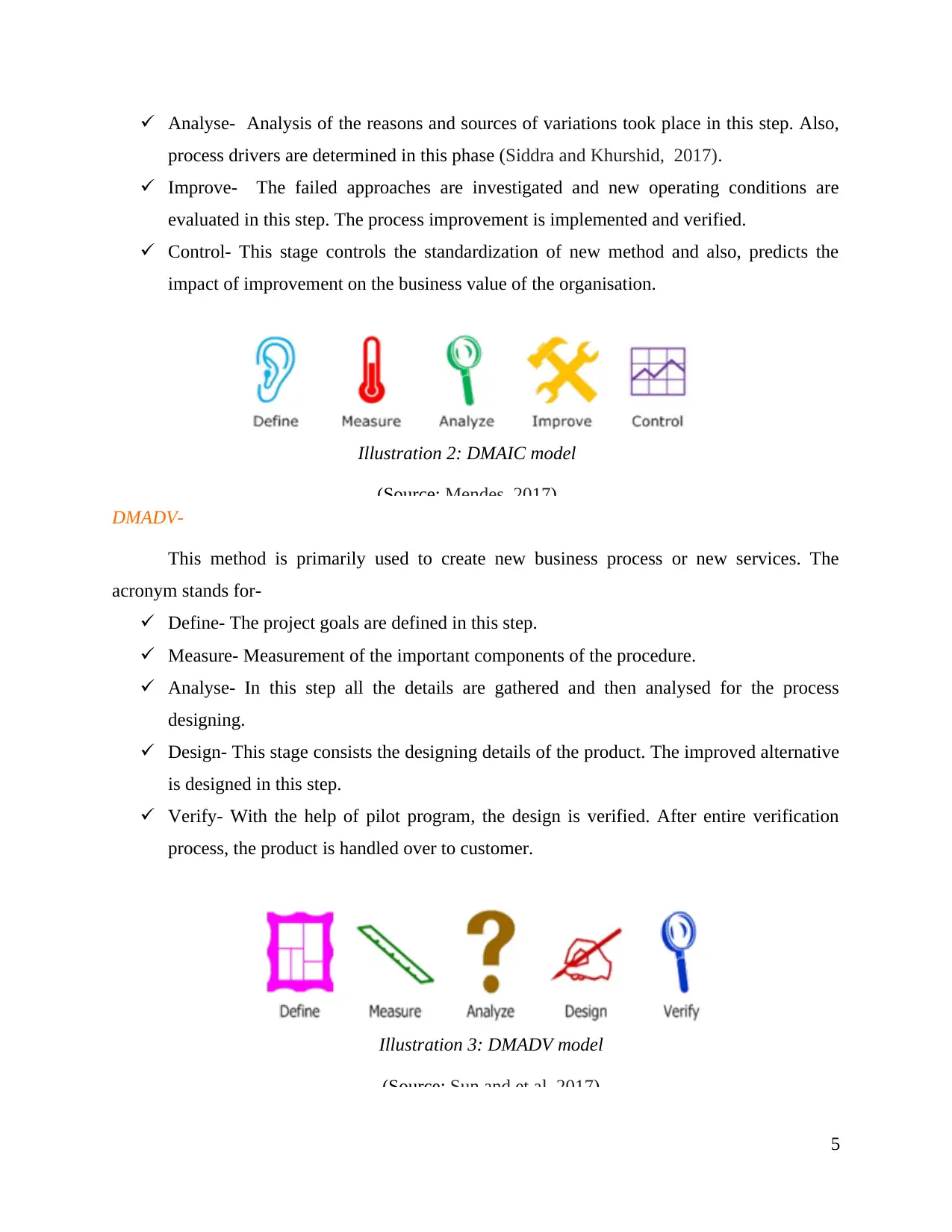
Analyse- Analysis of the reasons and sources of variations took place in this step. Also,
process drivers are determined in this phase (Siddra and Khurshid, 2017).
Improve- The failed approaches are investigated and new operating conditions are
evaluated in this step. The process improvement is implemented and verified.
Control- This stage controls the standardization of new method and also, predicts the
impact of improvement on the business value of the organisation.
DMADV-
This method is primarily used to create new business process or new services. The
acronym stands for-
Define- The project goals are defined in this step.
Measure- Measurement of the important components of the procedure.
Analyse- In this step all the details are gathered and then analysed for the process
designing.
Design- This stage consists the designing details of the product. The improved alternative
is designed in this step.
Verify- With the help of pilot program, the design is verified. After entire verification
process, the product is handled over to customer.
5
Illustration 2: DMAIC model
(Source: Mendes, 2017)
Illustration 3: DMADV model
(Source: Sun and et.al, 2017)
process drivers are determined in this phase (Siddra and Khurshid, 2017).
Improve- The failed approaches are investigated and new operating conditions are
evaluated in this step. The process improvement is implemented and verified.
Control- This stage controls the standardization of new method and also, predicts the
impact of improvement on the business value of the organisation.
DMADV-
This method is primarily used to create new business process or new services. The
acronym stands for-
Define- The project goals are defined in this step.
Measure- Measurement of the important components of the procedure.
Analyse- In this step all the details are gathered and then analysed for the process
designing.
Design- This stage consists the designing details of the product. The improved alternative
is designed in this step.
Verify- With the help of pilot program, the design is verified. After entire verification
process, the product is handled over to customer.
5
Illustration 2: DMAIC model
(Source: Mendes, 2017)
Illustration 3: DMADV model
(Source: Sun and et.al, 2017)
Paraphrase This Document
Need a fresh take? Get an instant paraphrase of this document with our AI Paraphraser

Both these six sigma planning methods plays an important role in attaining total quality
management of the entity. Every minute detail of the product development can be identified,
evaluated and controlled with this tool. In context to the total quality management of an event
management company, six sigma is a tool which plays a crucial role. Event sector is the field that
needs new innovations timely to weaken its competitors by enhancing its competitive edge
(Chiarini and Chiarini, 2017) .Penguins Limited should consider this tool in its TQM as there are
numerous benefits associated with this tool for attaining the organisational success and some are
explained below-
Greater productivity- The six sigma tool enables the effective planing of the product
designing and thus, services can be designed in an effective way depending upon the
evaluation of customer requirements which helps entity in greater production. Thus,
resultant to this, high profitability can be achieved by the establishment.
Improved quality- Through six sigma tool, the prepared product is first analysed which
enables the development of lacking factor, if any. This product development results in
improves quality of the service (Sun and et.al, 2017) .
Improved customer loyalty- Implementation of six sigma in the entity results in
suppression of risk of dissatisfied customers. The customer retention is the main aim of
an establishment to increase its productivity.
Strategic planning- Implementation of this tool in the strategic planning of your entity
will help the business value of the organisation to a much greater extent. It provides the
management team with the complete idea of all the resources which are being used in the
entity.
Supply chain management- This tool balance the supply chain of the organisation. This
balance is really necessary in increasing productivity of the company. Further, it effects
the logistic strategy of the establishment in a positive way.
Cost Reduction- This tool suppress the huge amount of money used in the services. This
reduced cost is a sign of return in investment, proposing more funds to apply on the other
services (Alexander, 2017) . If the cost associated with the development of the product
will be suppressed it will directly increase the profitability of the business.
6
management of the entity. Every minute detail of the product development can be identified,
evaluated and controlled with this tool. In context to the total quality management of an event
management company, six sigma is a tool which plays a crucial role. Event sector is the field that
needs new innovations timely to weaken its competitors by enhancing its competitive edge
(Chiarini and Chiarini, 2017) .Penguins Limited should consider this tool in its TQM as there are
numerous benefits associated with this tool for attaining the organisational success and some are
explained below-
Greater productivity- The six sigma tool enables the effective planing of the product
designing and thus, services can be designed in an effective way depending upon the
evaluation of customer requirements which helps entity in greater production. Thus,
resultant to this, high profitability can be achieved by the establishment.
Improved quality- Through six sigma tool, the prepared product is first analysed which
enables the development of lacking factor, if any. This product development results in
improves quality of the service (Sun and et.al, 2017) .
Improved customer loyalty- Implementation of six sigma in the entity results in
suppression of risk of dissatisfied customers. The customer retention is the main aim of
an establishment to increase its productivity.
Strategic planning- Implementation of this tool in the strategic planning of your entity
will help the business value of the organisation to a much greater extent. It provides the
management team with the complete idea of all the resources which are being used in the
entity.
Supply chain management- This tool balance the supply chain of the organisation. This
balance is really necessary in increasing productivity of the company. Further, it effects
the logistic strategy of the establishment in a positive way.
Cost Reduction- This tool suppress the huge amount of money used in the services. This
reduced cost is a sign of return in investment, proposing more funds to apply on the other
services (Alexander, 2017) . If the cost associated with the development of the product
will be suppressed it will directly increase the profitability of the business.
6
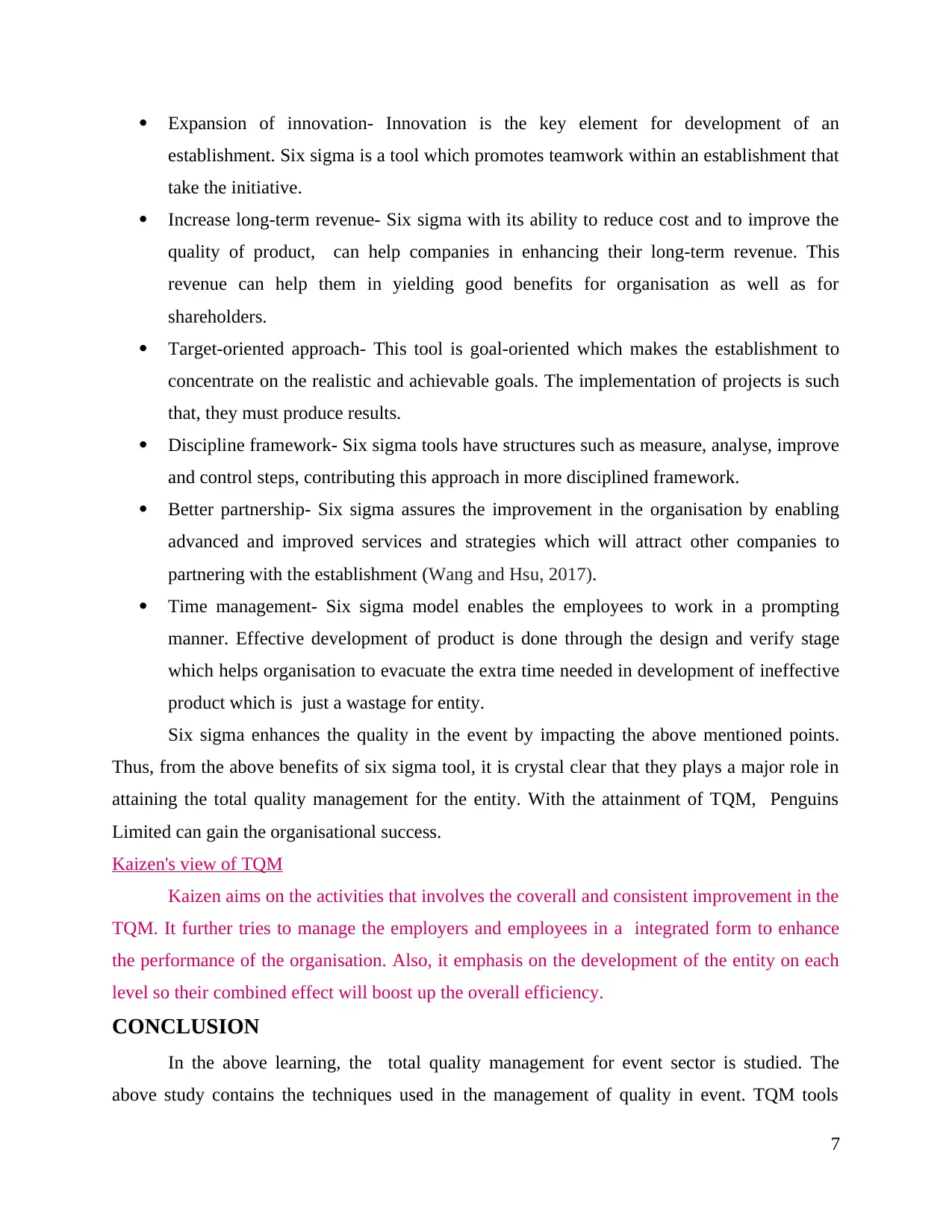
Expansion of innovation- Innovation is the key element for development of an
establishment. Six sigma is a tool which promotes teamwork within an establishment that
take the initiative.
Increase long-term revenue- Six sigma with its ability to reduce cost and to improve the
quality of product, can help companies in enhancing their long-term revenue. This
revenue can help them in yielding good benefits for organisation as well as for
shareholders.
Target-oriented approach- This tool is goal-oriented which makes the establishment to
concentrate on the realistic and achievable goals. The implementation of projects is such
that, they must produce results.
Discipline framework- Six sigma tools have structures such as measure, analyse, improve
and control steps, contributing this approach in more disciplined framework.
Better partnership- Six sigma assures the improvement in the organisation by enabling
advanced and improved services and strategies which will attract other companies to
partnering with the establishment (Wang and Hsu, 2017).
Time management- Six sigma model enables the employees to work in a prompting
manner. Effective development of product is done through the design and verify stage
which helps organisation to evacuate the extra time needed in development of ineffective
product which is just a wastage for entity.
Six sigma enhances the quality in the event by impacting the above mentioned points.
Thus, from the above benefits of six sigma tool, it is crystal clear that they plays a major role in
attaining the total quality management for the entity. With the attainment of TQM, Penguins
Limited can gain the organisational success.
Kaizen's view of TQM
Kaizen aims on the activities that involves the coverall and consistent improvement in the
TQM. It further tries to manage the employers and employees in a integrated form to enhance
the performance of the organisation. Also, it emphasis on the development of the entity on each
level so their combined effect will boost up the overall efficiency.
CONCLUSION
In the above learning, the total quality management for event sector is studied. The
above study contains the techniques used in the management of quality in event. TQM tools
7
establishment. Six sigma is a tool which promotes teamwork within an establishment that
take the initiative.
Increase long-term revenue- Six sigma with its ability to reduce cost and to improve the
quality of product, can help companies in enhancing their long-term revenue. This
revenue can help them in yielding good benefits for organisation as well as for
shareholders.
Target-oriented approach- This tool is goal-oriented which makes the establishment to
concentrate on the realistic and achievable goals. The implementation of projects is such
that, they must produce results.
Discipline framework- Six sigma tools have structures such as measure, analyse, improve
and control steps, contributing this approach in more disciplined framework.
Better partnership- Six sigma assures the improvement in the organisation by enabling
advanced and improved services and strategies which will attract other companies to
partnering with the establishment (Wang and Hsu, 2017).
Time management- Six sigma model enables the employees to work in a prompting
manner. Effective development of product is done through the design and verify stage
which helps organisation to evacuate the extra time needed in development of ineffective
product which is just a wastage for entity.
Six sigma enhances the quality in the event by impacting the above mentioned points.
Thus, from the above benefits of six sigma tool, it is crystal clear that they plays a major role in
attaining the total quality management for the entity. With the attainment of TQM, Penguins
Limited can gain the organisational success.
Kaizen's view of TQM
Kaizen aims on the activities that involves the coverall and consistent improvement in the
TQM. It further tries to manage the employers and employees in a integrated form to enhance
the performance of the organisation. Also, it emphasis on the development of the entity on each
level so their combined effect will boost up the overall efficiency.
CONCLUSION
In the above learning, the total quality management for event sector is studied. The
above study contains the techniques used in the management of quality in event. TQM tools
7
⊘ This is a preview!⊘
Do you want full access?
Subscribe today to unlock all pages.

Trusted by 1+ million students worldwide
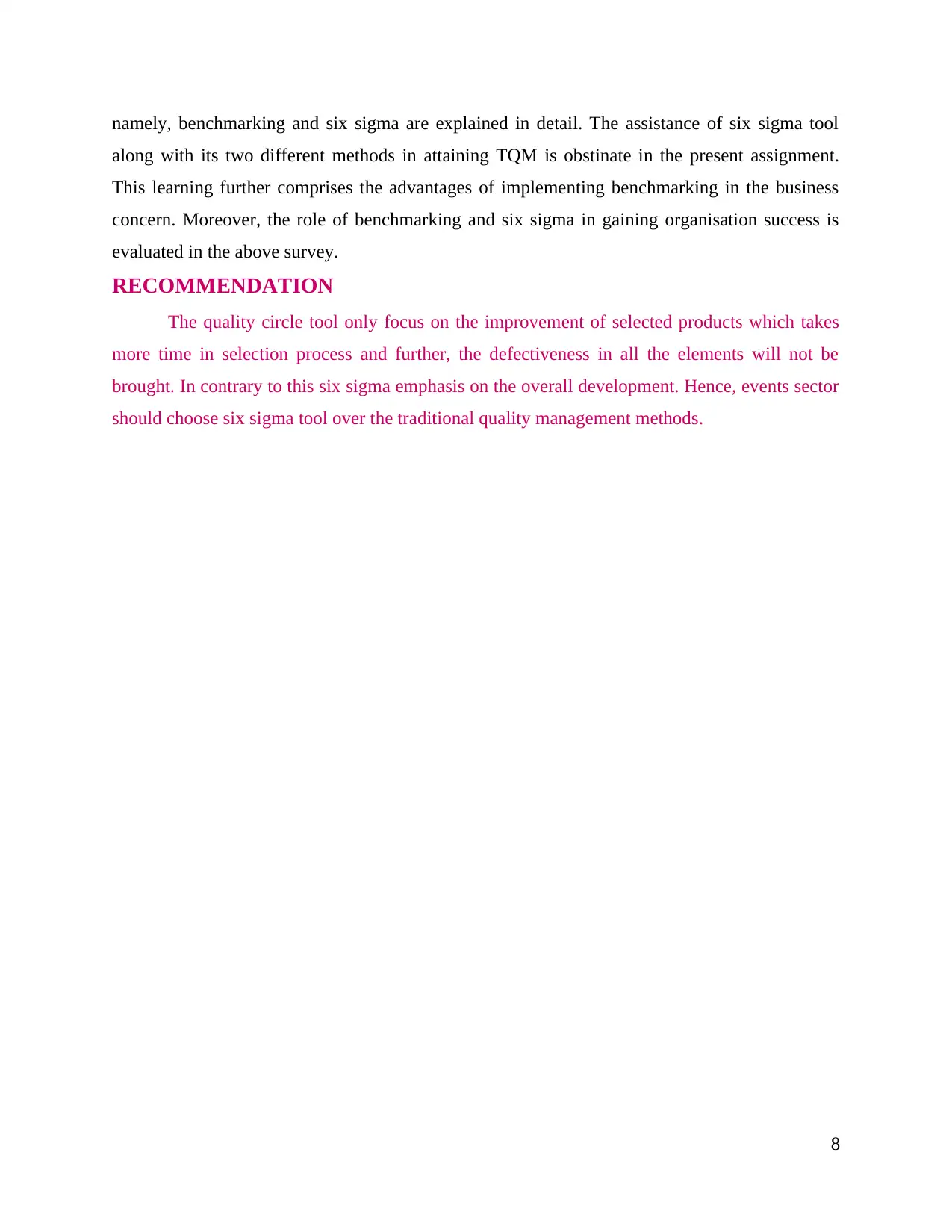
namely, benchmarking and six sigma are explained in detail. The assistance of six sigma tool
along with its two different methods in attaining TQM is obstinate in the present assignment.
This learning further comprises the advantages of implementing benchmarking in the business
concern. Moreover, the role of benchmarking and six sigma in gaining organisation success is
evaluated in the above survey.
RECOMMENDATION
The quality circle tool only focus on the improvement of selected products which takes
more time in selection process and further, the defectiveness in all the elements will not be
brought. In contrary to this six sigma emphasis on the overall development. Hence, events sector
should choose six sigma tool over the traditional quality management methods.
8
along with its two different methods in attaining TQM is obstinate in the present assignment.
This learning further comprises the advantages of implementing benchmarking in the business
concern. Moreover, the role of benchmarking and six sigma in gaining organisation success is
evaluated in the above survey.
RECOMMENDATION
The quality circle tool only focus on the improvement of selected products which takes
more time in selection process and further, the defectiveness in all the elements will not be
brought. In contrary to this six sigma emphasis on the overall development. Hence, events sector
should choose six sigma tool over the traditional quality management methods.
8
Paraphrase This Document
Need a fresh take? Get an instant paraphrase of this document with our AI Paraphraser
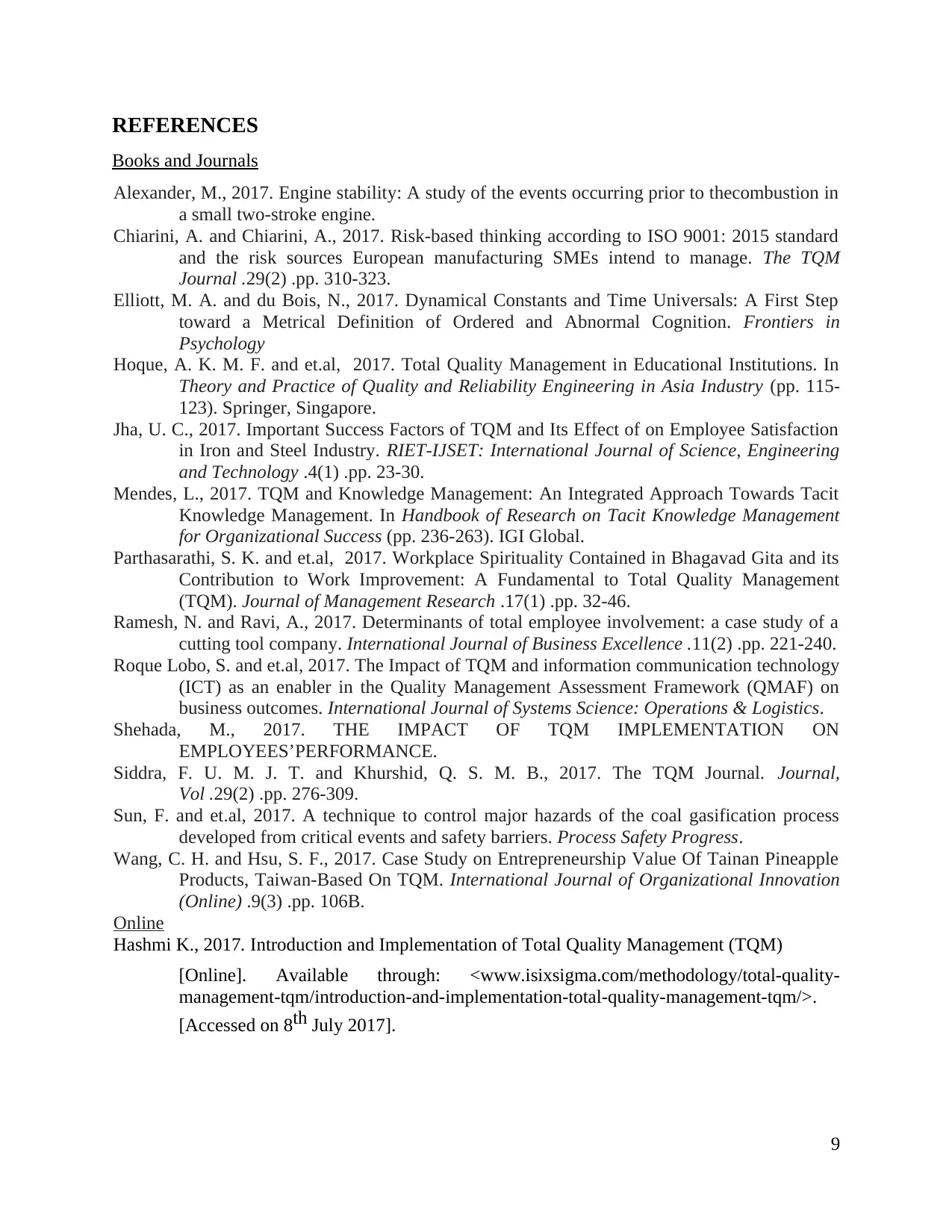
REFERENCES
Books and Journals
Alexander, M., 2017. Engine stability: A study of the events occurring prior to thecombustion in
a small two-stroke engine.
Chiarini, A. and Chiarini, A., 2017. Risk-based thinking according to ISO 9001: 2015 standard
and the risk sources European manufacturing SMEs intend to manage. The TQM
Journal .29(2) .pp. 310-323.
Elliott, M. A. and du Bois, N., 2017. Dynamical Constants and Time Universals: A First Step
toward a Metrical Definition of Ordered and Abnormal Cognition. Frontiers in
Psychology
Hoque, A. K. M. F. and et.al, 2017. Total Quality Management in Educational Institutions. In
Theory and Practice of Quality and Reliability Engineering in Asia Industry (pp. 115-
123). Springer, Singapore.
Jha, U. C., 2017. Important Success Factors of TQM and Its Effect of on Employee Satisfaction
in Iron and Steel Industry. RIET-IJSET: International Journal of Science, Engineering
and Technology .4(1) .pp. 23-30.
Mendes, L., 2017. TQM and Knowledge Management: An Integrated Approach Towards Tacit
Knowledge Management. In Handbook of Research on Tacit Knowledge Management
for Organizational Success (pp. 236-263). IGI Global.
Parthasarathi, S. K. and et.al, 2017. Workplace Spirituality Contained in Bhagavad Gita and its
Contribution to Work Improvement: A Fundamental to Total Quality Management
(TQM). Journal of Management Research .17(1) .pp. 32-46.
Ramesh, N. and Ravi, A., 2017. Determinants of total employee involvement: a case study of a
cutting tool company. International Journal of Business Excellence .11(2) .pp. 221-240.
Roque Lobo, S. and et.al, 2017. The Impact of TQM and information communication technology
(ICT) as an enabler in the Quality Management Assessment Framework (QMAF) on
business outcomes. International Journal of Systems Science: Operations & Logistics.
Shehada, M., 2017. THE IMPACT OF TQM IMPLEMENTATION ON
EMPLOYEES’PERFORMANCE.
Siddra, F. U. M. J. T. and Khurshid, Q. S. M. B., 2017. The TQM Journal. Journal,
Vol .29(2) .pp. 276-309.
Sun, F. and et.al, 2017. A technique to control major hazards of the coal gasification process
developed from critical events and safety barriers. Process Safety Progress.
Wang, C. H. and Hsu, S. F., 2017. Case Study on Entrepreneurship Value Of Tainan Pineapple
Products, Taiwan-Based On TQM. International Journal of Organizational Innovation
(Online) .9(3) .pp. 106B.
Online
Hashmi K., 2017. Introduction and Implementation of Total Quality Management (TQM)
[Online]. Available through: <www.isixsigma.com/methodology/total-quality-
management-tqm/introduction-and-implementation-total-quality-management-tqm/>.
[Accessed on 8th July 2017].
9
Books and Journals
Alexander, M., 2017. Engine stability: A study of the events occurring prior to thecombustion in
a small two-stroke engine.
Chiarini, A. and Chiarini, A., 2017. Risk-based thinking according to ISO 9001: 2015 standard
and the risk sources European manufacturing SMEs intend to manage. The TQM
Journal .29(2) .pp. 310-323.
Elliott, M. A. and du Bois, N., 2017. Dynamical Constants and Time Universals: A First Step
toward a Metrical Definition of Ordered and Abnormal Cognition. Frontiers in
Psychology
Hoque, A. K. M. F. and et.al, 2017. Total Quality Management in Educational Institutions. In
Theory and Practice of Quality and Reliability Engineering in Asia Industry (pp. 115-
123). Springer, Singapore.
Jha, U. C., 2017. Important Success Factors of TQM and Its Effect of on Employee Satisfaction
in Iron and Steel Industry. RIET-IJSET: International Journal of Science, Engineering
and Technology .4(1) .pp. 23-30.
Mendes, L., 2017. TQM and Knowledge Management: An Integrated Approach Towards Tacit
Knowledge Management. In Handbook of Research on Tacit Knowledge Management
for Organizational Success (pp. 236-263). IGI Global.
Parthasarathi, S. K. and et.al, 2017. Workplace Spirituality Contained in Bhagavad Gita and its
Contribution to Work Improvement: A Fundamental to Total Quality Management
(TQM). Journal of Management Research .17(1) .pp. 32-46.
Ramesh, N. and Ravi, A., 2017. Determinants of total employee involvement: a case study of a
cutting tool company. International Journal of Business Excellence .11(2) .pp. 221-240.
Roque Lobo, S. and et.al, 2017. The Impact of TQM and information communication technology
(ICT) as an enabler in the Quality Management Assessment Framework (QMAF) on
business outcomes. International Journal of Systems Science: Operations & Logistics.
Shehada, M., 2017. THE IMPACT OF TQM IMPLEMENTATION ON
EMPLOYEES’PERFORMANCE.
Siddra, F. U. M. J. T. and Khurshid, Q. S. M. B., 2017. The TQM Journal. Journal,
Vol .29(2) .pp. 276-309.
Sun, F. and et.al, 2017. A technique to control major hazards of the coal gasification process
developed from critical events and safety barriers. Process Safety Progress.
Wang, C. H. and Hsu, S. F., 2017. Case Study on Entrepreneurship Value Of Tainan Pineapple
Products, Taiwan-Based On TQM. International Journal of Organizational Innovation
(Online) .9(3) .pp. 106B.
Online
Hashmi K., 2017. Introduction and Implementation of Total Quality Management (TQM)
[Online]. Available through: <www.isixsigma.com/methodology/total-quality-
management-tqm/introduction-and-implementation-total-quality-management-tqm/>.
[Accessed on 8th July 2017].
9
1 out of 11
Related Documents
Your All-in-One AI-Powered Toolkit for Academic Success.
+13062052269
info@desklib.com
Available 24*7 on WhatsApp / Email
![[object Object]](/_next/static/media/star-bottom.7253800d.svg)
Unlock your academic potential
Copyright © 2020–2025 A2Z Services. All Rights Reserved. Developed and managed by ZUCOL.




